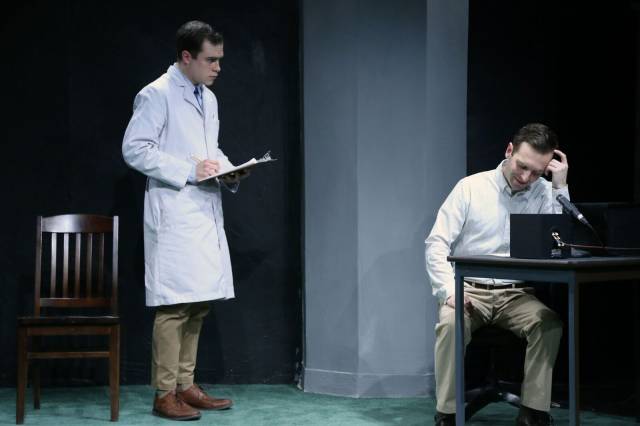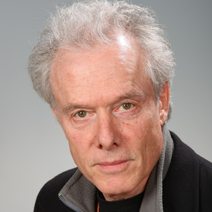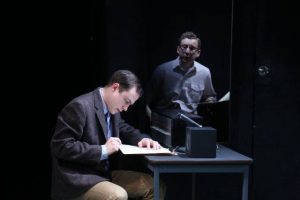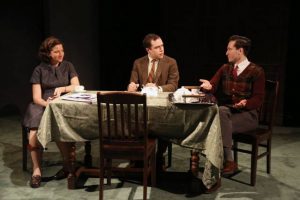

From every action and decision made, there are consequences. Social psychologist Stanley Milgram, eager to understand those that assisted with or turned a blind eye to the systematic atrocities of the Holocaust, carried out a series of obedience experiments at Yale University in the early sixties to test how ordinary people, in this case Yale students, might respond to an authoritative order to administer electric shocks upon a fellow volunteer, for the simple crime of answering a set of word-association questions incorrectly. The results, astounding and worrying to many, continue to stir debate more than half a century on.
The Ensemble Studio Theatre, whose recent successes include Tony-nominated Hand to God and the recent West End run of Photograph 51 starring Nicole Kidman, is partnered with the Alfred P. Sloan Foundation. Here, William Carden, EST's artistic director and director of Please Continue, talks to StageBuddy about Stanley Milgram and the play's development.
Tell me about EST's collaboration with the Sloan Foundation.
It's a long relationship we've had with the Alfred P. Sloan Foundation and we're now in our eighteenth year. I've been artistic director here for eight years, so that's how I've been involved with the program. We have Graeme Gillis who's the associate artistic director and also the director of that program. It's a program where we commision, develop and produce plays that tell the stories of science. It's part of an initiative to enhance the public understanding of science and understanding, who we are as human beings and what it is that makes us human. That's really why the program exists. Frank [Basloe]'s play is something we've worked on over the last five years. We've developed it here but it was originally commissioned by the Center Theater Group in Los Angeles, a much earlier and very different version, and then we started working on it with him.
 So he started writing it independently and then you joined forces?
So he started writing it independently and then you joined forces?
Yeah, I knew Frank because I'd worked with him before and as artistic director, I wanted writers who I thought would be good for people to possibly commission. And so I talked to him and he said, "Well I actually have this play on the Milgram experiments but it's very much an early draft." And I said, "Let me see it." I looked at it and he had these two stories on what happened at Yale at around that time, but he hadn't found a way to really get them to work together. So that became what we worked on and the play went through different iterations to try to find that. About two years ago we did a workshop. We rehearsed for three weeks and performed it for a week and that was where we finally had two stories to alternate throughout and be in the same time-frame and have one story refer to another. From there we did more work, especially on the Coffin/Dunleavy part of the story, to get it to be what you saw last week.
How much did you know about the Milgram Experiment in advance of the play?
I didn't know a lot. I knew that they happened. I knew about him, but I didn't know a lot. I've read quite a bit about it and watched videos and read the biography of Milgram and looked at the book he wrote, Obedience to Authority. And also the book Gina Perry wrote about Milgram (Behind the Shock Machine), questioning the experiments.
What kind of impact do you think the experiments have on society now? What do you think they say and what should we learn from them?
You know it's very controversial because many people question the ethics and they question the methodology, but I think what is interesting is that no one really questions that they do tell us something. They're not experiments people would run today in that way, they wouldn't be allowed to. There was a lot of that kind of experimentation being done around that time in the late 1950s and early 1960s. There was a show on TV called Candid Camera, you know, people wouldn't do that today. They do other more bizarre things now on TV, but I don't think they'd do that today. I think that's what makes the experiments fascinating. They do try to explore how we come to do things in counter to our conscience and I think that's what Frank is exploring in the play. How we respond to something and how we obey is a really interesting thing to look at.
The character of Milgram comes across as quirky and humorous and yet his commitment to his work is exemplified by his impatience with James Sanders' conscientious doubts. How accurate is this portrayal and how much is known about the real man's character, or was that not so relevant given the fictional plot woven into these historical events?
We've had people come to see the play who knew Milgram and they'll always say, "That was like him", "That wasn't like him", so I think that from everything I've read, Frank's portrayal very much captures the spirit of the guy. There was a guy who had been a PhD student with Milgram -- Milgram had been sort of his mentor -- and he said this portrayal of Milgram is far more accurate than the one in The Experimenter with Peter Sarsgaard playing him in the movie. [Sarsgaard] plays him as very subdued, a seemingly brooding and depressed man. In truth, he was very playful. He was very curious. He was mercurial. He played with people. He was also twenty-seven years old when he created this experiment and I think those are all factors that we tried to capture in how we brought him to life.
He went on to create other very interesting experiments like the whole idea of 'six degrees of separation'. That was his discovery. After Yale, he went back to Harvard where he'd been a graduate student. He really wanted to have tenure at Harvard, but he couldn't get tenure because of the controversial nature of these experiments. He ended up at CUNY and when he was there, he had his students run tests where they went on the subway and they asked people to give them their seat just to see what the response was. So they'd go off to an older person and say, "Could I have your seat?" So he was an interesting and very curious guy.

Please Continue explores the juxtaposition between the cold detachment of scientific research and the emotional human core at the center of it. Scientific integrity is up for debate when the ramifications and indeed consequences are scrutinized on such a personal level from different view points. With this is mind, how did you help your cast prepare?
I gave everyone this book that actually didn't have anything to do with the experiments. It had to do with Yale in 1960. it was called On the Cusp by a guy named Daniel Horowitz. He was in the class of 1960 at Yale and he wrote about what it was like to be at Yale at that time. I felt that part of what this play was about were these two very different rebels who were in that environment. One was Stanley Milgram and the other was William Sloane Coffin. They were in part reacting to what was a very privileged, elitist, conformist society with secret clubs and all of that kind of stuff.
But in terms of the actual experiments, people who were involved in that were Haskell King who plays Milgram, David Jackson who plays Sanders, Alex Herrald who plays [Harold] Burden and also Jonathan Silver who plays Saul Dashoff. We read about the experiments and we also watched archival film footage that Frank got hold of of the experiments. But the experiment at the end of the first act, it's pretty much verbatim how the experiments went, so it was kind of capturing that through just watching it and talking about it and exploring it.
Since you first workshopped the play two years ago, how varied have the audience reactions been and what are you hoping they will take away with them?
You know, I've been trying to get a sense of what people are taking away from the play. I haven't had people telling me they hated it or they found it offensive. I have had people who felt very strongly that the message of those experiments needed to be heard. One of them was a woman who works at the United Nations. She works with some of the atrocities that are happening in Africa. She saw that behavior reflected in the play.
I think two things. One is understanding how we can come to do those things. With the parallel story of Dunleavy going to William Sloane Coffin, Frank and I were really trying to explore how, if you commit an unconscionable act, what do you do, if you really want to not deny it? And that's where the idea of atonement came -- and I kept saying to Frank, "What is atonement?" I think what we arrived at is what is in the last scene between Coffin and Dunleavy where he talks about going into the room where the girl was and not leaving, knowing he shouldn't be there but going ahead anyway. And then Coffin tells the story of when he was twenty-one years old and was charged with working as an interpreter with these Russian deserters who were being held and not being told that they were going to be forcibly taken back to Russia - and sitting through the performance the night before that surprise round-up was gonna happen, with Coffin not saying anything and then watching the next day while some of them took their own lives rather than go back. What he says at the end of that story, and this is actually true because Coffin writes about it in his own autobiography (Once to Every Man) - he said what happened there stayed with him for the rest of his life and informed decisions he made and very specifically informed the decision he made to actively protest the Vietnam War, which he did and was very famous for. He was jailed and he gave sanctuary to draft resistors in the Yale chapel, much to the horror of Kingman Brewster (Yale president). That decision was informed by the experience of not speaking up. I wanted the play to make us all think about that and how we make those decisions, how we make them under pressure and how we can not make them.
Like much of your audience and presumably everyone who worked on the play, I wonder what answers you came up with if and when you posed the question of how you might have reacted in the same position as Milgram's unwitting volunteers.
I would say, I would be vulnerable to obedience. I think you know as Sanders does, he looks at the experiments and says, "I wouldn't do that." But in another way he's doing it. And I know I've done that in my life.

Would you say that when such tests are carried out in an academic setting, people are more prone to putting their trust in authority?
Yes. Milgram ran the experiment with many different variations. There were some where the experimenter wore a lab coat as he does in our experiment, and others where he did not, and that made some but not a huge difference. He also ran them where the experimenter left the guy alone in the room and sometimes he would cheat. They ran them with women, they ran them where the guy was actually sitting next to the learner and has to touch him. He explored it in many different ways. That's what I found very interesting about it. You know, it's very easy - you want to think of yourself not doing it but then you think about things in your life. You think of things you've done that are actually in that direction. In a way, I think it's a play that's trying to open our awareness.
Too often, period plays fall into an affected delivery, but there's a real authenticity to how your cast play with the time and setting. Tell me a little bit about the casting and any research you might have asked them to do.
I did give everyone the book that I mentioned earlier that talks about 1960, about how they dressed, about what kind of a lifestyle was there at Yale at that time. It talked about people, that there were three classes of students, there were the insiders, Yale men who often came from the prestigious prep schools. And the fact that Yale was known for creating successful men, that was the model. And your club life was as important as your academic life, in that sense. And then there were the outsiders. So in our mind, Dunleavy and Halverson were like Yale men. Sanders, who did the experiment, and his Jewish friend Dashoff were outsiders. They weren't in the clubs. They were more academically focused and that's how they were living in that environment. The third were people who were real rebels. In terms of the students, they don't really appear in the play. So we did that. Frank captured it in the writing so it was actually getting them comfortable with what could seem like sculpted language today, because they just had a more formal way of talking.
You know, I think Jason Simms (scenic designer) did a great job of giving us an environment that captured Yale without being literal. We decided that the two big elements were wood paneling and stone columns, and if we could find a way to make this work, we wanted to invoke the world in a non-literal way. Also, Suzanne Chesney, who's the costume designer, she really knew the specific signifiers and one of them was hair. So we had a hair guy come in to do everyone's haircuts. Because actually if you look at photographs of that time, yeah the clothes are different, but the hair is really different. It was kind of all of those things working together. And also we'd done workshops two years ago. Many of the actors were in that, and I knew then that when we cast the two roles that weren't in the workshop, Milgram and Sanders, we'd have actors who were comfortable with language, because these characters use language a little bit differently than the way we talk today. So they've had some of that training.
EST's collaboration with the The Alfred P. Sloan Foundation has produced some impressive successes. Other than what you've been doing already, what is the direction you wish to take future projects that marry art and drama with science and technology?
We do one production a year but we have forty plays commissioned in this program. We're doing a co-production with the Keen Company, a play by Anna Ziegler called Boy and that starts performing on February 26th. I'm not sure what our production will be next year but we have many plays that we're always doing readings and workshops of, to see where they are and what we can do. What I love about the program is that real interesting plays are starting to come out of it. Photograph 51 - that play just opened on the West End in London with Nicole Kidman. We produced that play here. We just want to do more plays that deliver that kind of good story.
"Please Continue" is at the Ensemble Studio Theatre through February 28.